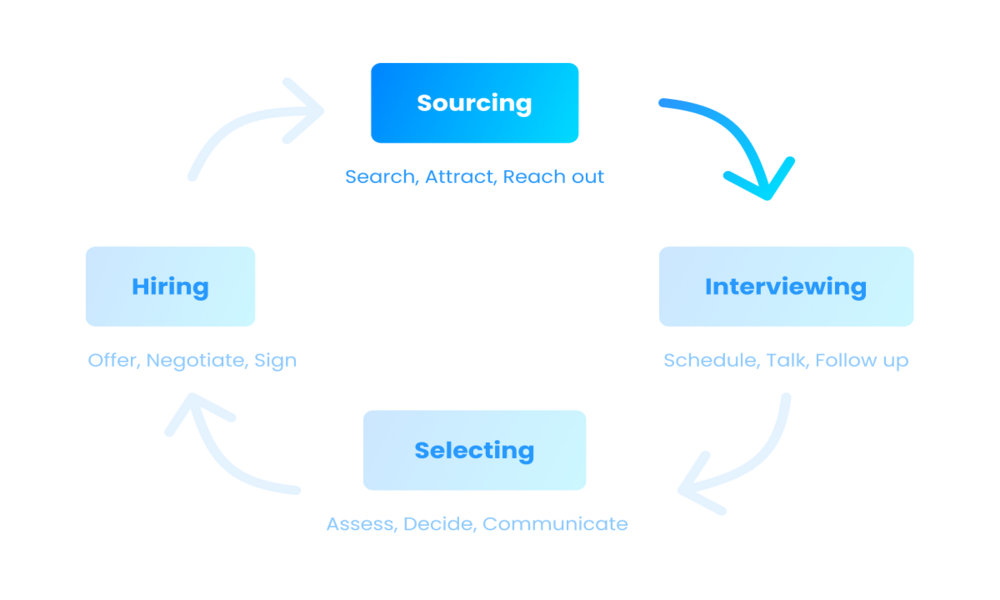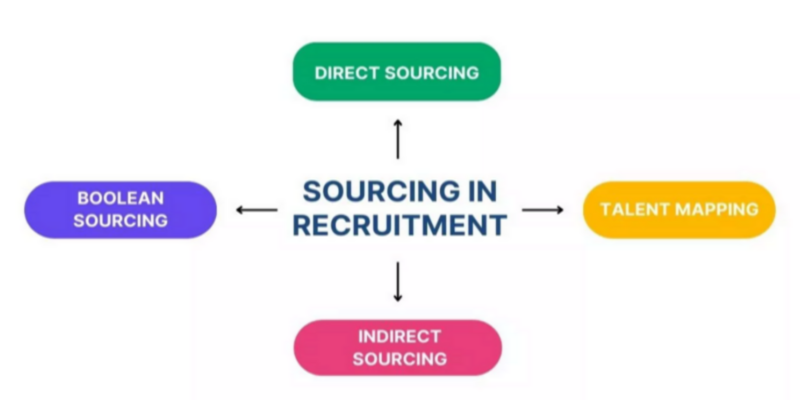Table of Contents
Sourcing is a critical and proactive phase in the IT recruitment process, where the goal is to find and engage potential candidates, especially those who may not be actively job-hunting. Given the competitive nature of the tech industry, where demand for specialized skills is high, sourcing becomes a fundamental step in connecting with talent who might otherwise go unnoticed in a traditional recruitment funnel. Let’s explore what sourcing entails, how it’s different from general recruitment, and why it’s vital in IT.
Defining sourcing in recruitment
At its core, sourcing is the process of identifying and reaching out to potential candidates who fit specific roles within a company. In IT recruitment, sourcers and recruiters actively look for candidates with unique or niche skills, often required for complex technical positions. This search includes passive candidates who may not be seeking new roles but could be open to a move if approached with the right opportunity.
This initial phase of recruitment involves building a detailed profile of the ideal candidate, scanning industry databases, leveraging social networks like LinkedIn or GitHub, and even using specialized tools to find the right individuals. Unlike conventional recruitment, which starts once candidates apply, sourcing starts by actively seeking them out.

Sourcing vs. Recruitment: key differences
While sourcing and recruitment are often used interchangeably, they play distinct roles within the hiring process. Sourcing is the groundwork stage where recruiters identify and establish contact with candidates, creating a pool of prospects who match the required qualifications. Recruitment, on the other hand, involves assessing these candidates through interviews and other evaluation methods to determine if they are the right fit for the company.
In larger organizations, sourcing is typically managed by specialized talent sourcers who dedicate time to building talent pipelines and nurturing relationships with candidates. Smaller companies, however, may combine sourcing and recruiting into a single role due to resource constraints. For optimal results, especially in tech recruitment, separating sourcing from recruitment allows teams to focus on building relationships with candidates and enables recruiters to engage fully in the hiring process once a pool of qualified candidates is established.
Effective sourcing techniques in IT recruitment
Given the tech industry’s fast pace and specific skill requirements, sourcing in IT requires a mix of strategies tailored to target the right audience. Here are some effective techniques that can boost sourcing success:
- Define a detailed candidate profile: The foundation of effective sourcing lies in knowing precisely what qualifications, experience, and personality traits are needed for the role. Create a candidate persona that reflects both the hard skills (like proficiency in specific programming languages) and soft skills (such as adaptability or teamwork) that are important for the role. By knowing the “ideal” candidate, sourcers can focus their efforts on identifying individuals who align with the company’s culture and technical requirements.
- Leverage multiple sourcing channels: For successful sourcing, casting a wide net across various platforms is essential. Social media platforms like LinkedIn, GitHub, are valuable resources for finding IT talent. Additionally, participating in specialized forums, online communities, and even university career fairs can help identify emerging talent. By diversifying sourcing channels, companies increase the chance of finding the right fit, especially for hard-to-fill tech roles.
- Build and maintain a talent database: Sourcing is not just about immediate hiring needs; it’s about creating a long-term strategy. Building a candidate database allows sourcers to store valuable information on candidates they may want to approach for future roles. This pipeline of potential hires can be a critical asset when a new position opens, enabling a quicker response to staffing needs. Tools like ATS (Applicant Tracking Systems) can streamline the management of this database and help recruiters easily access candidate profiles when required.
- Use advanced sourcing tools: Sourcing tools can streamline the process of finding and contacting candidates. Boolean searches on search engines and specialized recruitment tools (such as LinkedIn Recruiter, GitHub) help recruiters create precise search parameters, narrowing down their results to find candidates with specific skills or qualifications. Automated messaging systems also make it easier to engage with candidates at scale, keeping communication efficient and timely.
- Enhance Your employer brand: A strong employer brand can make sourcing efforts significantly easier. Candidates in the tech industry often research potential employers before responding to outreach messages. Building a positive online presence—through reviews, social media, and showcasing company culture—can increase interest from candidates. A well-regarded brand attracts quality talent and strengthens candidate engagement during the sourcing stage.
Challenges in sourcing IT talent
Sourcing in IT recruitment has distinct challenges. It is a time-intensive process that requires substantial resources, especially when searching for candidates with specialized skills or extensive experience. Engaging passive candidates can be difficult, as many are often satisfied with their current positions. Additionally, missteps during the outreach process—such as impersonal messages or inaccuracies in job descriptions—can lead to a negative candidate experience and harm a company’s reputation.
Tech candidates are also approached frequently by other recruiters, so a company’s initial contact must be meaningful and well-crafted to stand out. A message that highlights unique aspects of the role, potential growth opportunities, and the organization’s mission is far more likely to catch a candidate’s attention than a generic job description.
Advantages of a strong sourcing strategy
Despite these challenges, an effective sourcing strategy brings several advantages to the recruitment process:
- Wider talent pool: Active sourcing expands the reach beyond active job seekers, tapping into a broader and often more experienced candidate pool.
- Improved quality of fire: By targeting individuals with specific skills and experience, sourcers can ensure a closer match to job requirements, improving the overall quality of hires.
- Faster time to fill: Having a talent pipeline ready enables faster responses to urgent hiring needs, as recruiters can approach pre-qualified candidates quickly.
- Enhanced employer reputation: Consistent and positive interactions with candidates, even those who are not hired immediately, can improve a company’s reputation in the job market. After all, the Candidate Experience plays a key role here.
Summary
In the competitive IT recruitment landscape, sourcing is an essential process that empowers companies to connect with skilled candidates in a proactive and targeted manner. By developing a comprehensive sourcing strategy, building a talent database, leveraging advanced tools, and crafting engaging outreach messages, recruiters can effectively navigate the challenges of sourcing for niche and high-demand roles.
Sourcing in IT is not just the first step of recruitment—it’s a strategic initiative that sets the foundation for a successful hiring process, helping organizations attract and retain the best talent in a challenging market. Whether a company is looking for a front-end developer, a DevOps specialist, or a cybersecurity expert, a strong sourcing approach can make all the difference.

